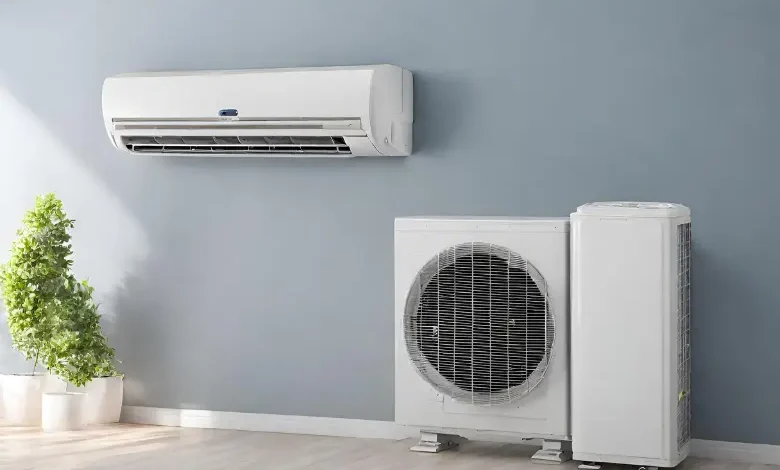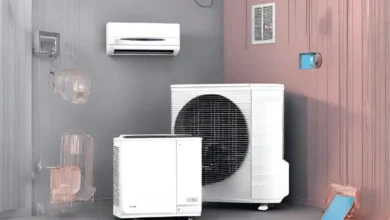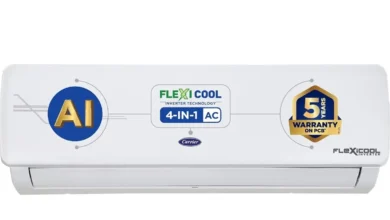Embracing Comfort and Sustainability: A Comprehensive Guide to Energy-Efficient Air Conditioning Solutions

In the face of climate change, our pursuit of comfort has taken on a new dimension—one that necessitates a blend of efficiency and environmental consciousness. Energy-efficient air conditioning systems have emerged as pivotal players in this evolving landscape. Beyond merely cooling our living spaces, these systems promise optimal performance and reduced carbon footprints. In this comprehensive guide, we delve into the intricate details of three fundamental components of energy-efficient air conditioning, each contributing to a harmonious synthesis of comfort and sustainability.
Also read: Best AC in India 2024
Also read: Best AC in India 2024
Energy-Efficient Air Conditioning Solutions
1. High SEER Ratings: The Cornerstone of Efficiency
Defining SEER Ratings
Seasonal Energy Efficiency Ratio (SEER) stands as the bedrock metric for assessing the efficiency of air conditioning units. A numerical representation, SEER ratings signify the ratio of cooling output to energy input over a season. The higher the SEER rating, the more energy-efficient the system.
Benefits of High SEER Ratings
Investing in air conditioning units with high SEER ratings translates to substantial long-term savings on energy bills. These units are designed to optimize energy consumption, delivering effective cooling with minimal waste. While the upfront costs might be marginally higher, the return on investment becomes evident over time through reduced energy expenses.
High SEER-rated systems are engineered to operate efficiently even in challenging conditions, providing consistent comfort without overburdening the power grid. This not only benefits homeowners financially but also contributes to broader energy conservation initiatives, addressing the increasing demand for sustainable cooling solutions.
The Technological Advances Behind High SEER Ratings
The efficacy of high SEER-rated air conditioning units lies in advanced technologies that maximize efficiency. Variable-speed compressors, for example, adjust cooling output based on the specific needs of the moment, avoiding unnecessary energy consumption during periods of lower demand. Moreover, improved insulation and smart sensors enhance the overall performance of these systems, ensuring optimal cooling without energy wastage.
Calculating the Long-Term Savings
To truly appreciate the long-term savings associated with high SEER ratings, it’s essential to understand the calculations involved. Consider a scenario where a homeowner upgrades from a unit with a SEER rating of 12 to one with a rating of 18. The annual savings can be calculated by determining the percentage increase in efficiency and applying it to the energy costs.

With this formula, homeowners can estimate the potential annual savings on their energy bills, providing a clear picture of the economic advantages associated with higher SEER ratings.
2. Programmable Thermostats: Mastering Temperature Optimization
Unraveling Programmable Thermostats
Programmable thermostats are a technological marvel, empowering users to schedule cooling periods based on their daily routines. These devices offer a nuanced approach to temperature optimization, ensuring the air conditioning system operates precisely when needed and remains dormant during periods of inactivity.
Intelligent Scheduling for Optimal Comfort
Imagine returning home to a perfectly cooled environment without the need for continuous operation. Programmable thermostats achieve this by allowing homeowners to set temperature schedules that align with their daily lives. During working hours or vacations, the system can be programmed to conserve energy, activating only when necessary.
The benefits extend beyond convenience, as intelligent scheduling minimizes energy consumption, contributing to a more sustainable and eco-friendly lifestyle. By strategically adjusting temperatures based on occupancy patterns, homeowners not only enhance their comfort but also participate in responsible energy management.
Technological Features Enhancing User Experience
The evolution of programmable thermostats has seen the integration of smart technologies that further enhance user experience. Wi-Fi connectivity allows homeowners to control and monitor their air conditioning systems remotely, providing real-time insights into energy usage and temperature settings. Machine learning algorithms enable these thermostats to adapt and optimize schedules based on user behavior, creating a truly adaptive and efficient cooling experience.
Energy Reports and Usage Analytics
Many modern programmable thermostats come equipped with features such as energy reports and usage analytics. These tools empower homeowners with data-driven insights into their cooling patterns, helping them make informed decisions about energy conservation. By understanding peak usage times and identifying areas for improvement, users can refine their programming strategies to maximize efficiency.
3. Eco-Friendly Refrigerants: A Green Revolution in Cooling
Rethinking Refrigerants for Environmental Impact
Traditional refrigerants, such as hydrochlorofluorocarbons (HCFCs) and hydrofluorocarbons (HFCs), have long been associated with adverse environmental effects, including ozone depletion and global warming. The quest for more sustainable alternatives has led to a paradigm shift in the air conditioning industry.
The Environmental Toll of Conventional Refrigerants
The environmental impact of conventional refrigerants is a critical concern. HCFCs and HFCs, while effective in cooling, contribute significantly to the depletion of the ozone layer and the greenhouse effect. Recognizing these issues, researchers and manufacturers have intensified efforts to find alternatives that are both efficient in cooling and environmentally benign.
The Rise of Eco-Friendly Refrigerants
Manufacturers are increasingly adopting eco-friendly refrigerants with lower Global Warming Potential (GWP). These alternatives prioritize environmental consciousness without compromising cooling efficiency. Homeowners now have the opportunity to choose systems that not only provide exceptional comfort but also contribute to mitigating climate change.
Common Eco-Friendly Refrigerants
Several eco-friendly refrigerants have gained prominence in recent years. R-32, for instance, has a lower GWP than traditional HFCs, making it a popular choice for manufacturers committed to sustainability. R-410A, another widely used refrigerant, is being phased out due to its higher GWP, paving the way for next-generation alternatives that further reduce environmental impact.
The Importance of Proper Disposal and Recycling
As homeowners transition to air conditioning units that use eco-friendly refrigerants, proper disposal and recycling of old systems become crucial. Conventional refrigerants pose environmental risks if not handled correctly during disposal. However, with the increasing adoption of eco-friendly options, responsible disposal practices ensure a holistic approach to minimizing the overall impact of air conditioning on the environment.
Conclusion: Paving the Way to a Cooler, Greener Future
In conclusion, the journey towards energy-efficient air conditioning involves a strategic blend of technological advancements and environmental responsibility. High SEER ratings, programmable thermostats, and eco-friendly refrigerants stand as the pillars of this transformative approach to cooling solutions.
By understanding and embracing these components, homeowners not only experience long-term financial savings but also actively contribute to the broader goal of sustainable living. The interplay between optimal cooling and environmental consciousness defines the next era in air conditioning technology—a realm where comfort and eco-friendliness coexist harmoniously.
Going Beyond: Additional Considerations for Energy-Efficient Cooling
As technology continues to advance, additional considerations emerge, expanding the horizons of energy-efficient cooling solutions. Exploring these considerations further enriches our understanding of the comprehensive approach required for a truly sustainable and comfortable living environment.
4. Advanced Airflow Management Systems
Optimizing Air Circulation for Efficiency
Beyond SEER ratings and programmable thermostats, advanced airflow management systems play a pivotal role in enhancing the efficiency of air conditioning units. These systems focus on optimizing the circulation of cooled air within a space, ensuring uniform temperature distribution and reducing the workload on the cooling system
Variable-speed air handlers, for example, adjust the speed of the blower motor to match the cooling demands, providing precise control over airflow. This not only contributes to energy savings but also enhances comfort by eliminating hotspots and maintaining consistent temperatures throughout the home.
5. Energy Recovery Ventilation (ERV) Systems
Balancing Fresh Air and Energy Efficiency
Energy Recovery Ventilation (ERV) systems represent a breakthrough in maintaining indoor air quality while maximizing energy efficiency. These systems exchange stale indoor air with fresh outdoor air, but with a unique twist—they recover the energy from the outgoing air to precondition the incoming air.
During the cooling season, ERV systems transfer the coolness from the outgoing air to the incoming air, reducing the need for additional energy to cool the fresh air. This ingenious process not only enhances energy efficiency but also ensures a constant supply of fresh air, creating a healthier and more comfortable indoor environment.
6. Smart Grid Integration and Demand Response
Harmonizing Cooling with Grid Sustainability
As the concept of smart grids gains momentum, integrating air conditioning systems with these intelligent networks becomes a key consideration for maximizing efficiency. Smart grid integration enables air conditioners to communicate with the grid, allowing for dynamic adjustments in response to grid conditions and energy demand.
Demand response programs, for instance, empower homeowners to participate in energy-saving initiatives. During peak demand periods, the air conditioning system can temporarily adjust its operation, contributing to grid stability and potentially earning incentives for the homeowner.
7. Building Envelope Improvements
Sealing the Path to Efficiency
While air conditioning units play a crucial role in cooling indoor spaces, the efficiency of these systems can be compromised by a poorly sealed and insulated building envelope. Heat gain through walls, roofs, and windows increases the workload on the cooling system, reducing overall efficiency.
Investing in energy-efficient windows, proper insulation, and weather-stripping contributes to a well-sealed building envelope. This, in turn, minimizes the heat transfer between the indoor and outdoor environments, allowing the air conditioning system to operate more efficiently and maintain desired temperatures with less effort.
8. Lifecycle Assessments and Extended Producer Responsibility
A Holistic Approach to Sustainability
As consumers, understanding the lifecycle impact of air conditioning units and advocating for extended producer responsibility (EPR) can further enhance the sustainability of our cooling choices. Lifecycle assessments consider the environmental impact of a product from raw material extraction to disposal.
Choosing manufacturers that adhere to EPR principles ensures responsible end-of-life management of air conditioning units. This includes recycling components, properly disposing of refrigerants, and minimizing the overall environmental footprint of the product.
Conclusion: Navigating the Path to a Sustainable Cooling Future
In navigating the path to a sustainable cooling future, the considerations extend beyond the immediate features of air conditioning units. Advanced airflow management, energy recovery ventilation, smart grid integration, building envelope improvements, and a commitment to lifecycle assessments collectively contribute to a holistic and environmentally conscious approach.
As consumers, the power to shape the future of cooling lies in our choices. By embracing these advanced considerations and advocating for sustainable practices, we not only ensure our own comfort but also play a vital role in shaping a world where cooling is synonymous with efficiency, comfort, and environmental responsibility.
Final Thoughts: A Call to Action for Sustainable Cooling
In the grand tapestry of sustainable living, energy-efficient air conditioning emerges as a pivotal thread—one that intertwines comfort, efficiency, and environmental responsibility. As we delve into the intricate details of SEER ratings, programmable thermostats, eco-friendly refrigerants, advanced airflow management, ERV systems, smart grid integration, building envelope improvements, and lifecycle assessments, it becomes clear that our choices today echo far into the future.
The journey to a cooler, greener future is a collective endeavor. Homeowners, manufacturers, policymakers, and advocates must work hand in hand to promote and adopt sustainable cooling practices. From the initial decision to invest in high SEER-rated units to the responsible disposal of aging systems, each step contributes to a more sustainable and resilient world.
Let this comprehensive guide serve as a call to action—a blueprint for individuals and industries alike to embrace the synergy of comfort and sustainability. Through informed choices, technological advancements, and a shared commitment to environmental consciousness, we pave the way to a future where every breath of cool, refreshing air is a testament to our collective dedication to a greener, cooler planet.





